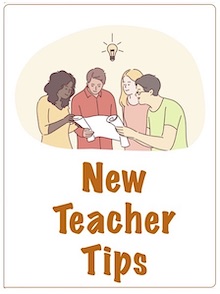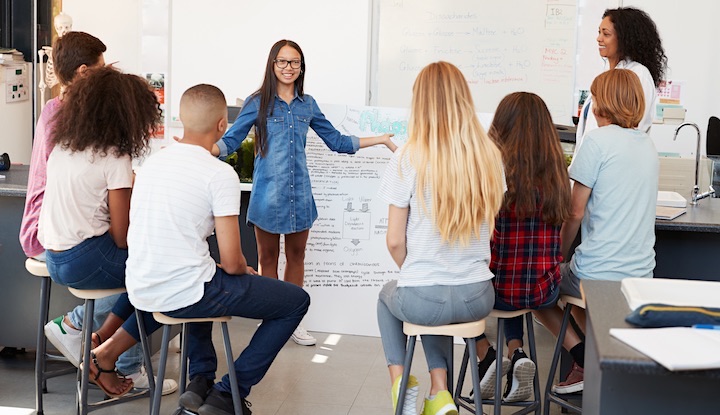7 Ways to Help Students Become Active Listeners
A MiddleWeb Blog

I take solace in the fact that my listening problem is widespread. Psychology Today, for instance, ran an article that stated 96 percent of us think we are good listeners, when in reality we only retain about half of what others say immediately after we’ve had a conversation.
In a classroom inundated with conversations, oral instructions, and academic vocabulary, poor listening skills can have long-term consequences. Teachers need tools to help students move beyond passive listening and instead develop the ability to actively and intentionally listen to, process, and comprehend what they hear.
What works to build listen skills
Luckily, there are some simple approaches and activities that we can employ to help our learners develop and improve their listening skills. I’ll briefly describe seven I’ve used in my own teaching.
►1. Pausing regularly to ask students to process information: During class presentations or discussion, pause frequently and ask students to make notes about the most significant things that they heard. By stopping regularly to summarize what is being said, we train our ears and brain to anticipate – to pay attention to and process what is going to be most important.
►2. Listening games: One of my favorite listening games is called It’s In the Bag. In the first round of the game, people work in teams to get their classmates to guess a word while being vague and evasive, using associations, examples or anything else other than the words on the cards themselves. Think of the old game show Password or another listening game called Taboo.
In the second round, players try to get their teammates to guess the same word by using a one word clue or trigger word from round one. For example, to get someone to say “Pizza Party” in the first round, someone could say, “Celebration with delicious slices of cheese and pepperoni flatbread.” To get them to guess it again in round two, someone could repeat a key word such as “slices.”
►3. Building instruction challenges: Lego Listen and Build is an activity that adds a hands-on dimension to active listening, allowing students to visualize the outcomes of their listening efforts. The approach is simple. A teacher provides students with Legos or similar building materials, then gives directions regarding which blocks should be used and how they should go together.
As students listen to instructions, they work to complete a building task in the way outlined by the teacher. At the end the teacher reveals a picture or model of what the final build should look like so that students can see how accurate their listening was.
Students are given multiple consecutive challenges to try to improve their listening skills. Find a variation here at Homemade Lego Listening Game.
►4. Adjusting classroom protocols: Introduce a structured approach that challenges students to process instructions thoroughly before taking action. I watched a teacher give instructions in a way she called “Ready? Go.”
The teacher prompts students by saying, “Listen carefully to the directions I am about to give. Do not begin until I say ‘Ready. Go.’” The teacher then gives directions such as putting away materials, pushing in chairs, and lining up. Then after a pause the teacher says…’Ready? Go.”
The greater the number of instructions and the longer the pause, the higher the degree of challenge for students trying to listen. This approach is designed to encourage students to listen to and process instructions before acting upon them.
►5. Listening comprehension quizzes: Teachers start by playing a short audio clip. Afterwards students are given a short quiz or discussion prompt to assess their understanding. The idea is to help reinforce the connection between listening and comprehension and encourage students to actively engage with the content.
►6. Call and response: To gain student attention before giving instructions, many educators use call and response techniques where they provide a call before students answer with a response. These methods not only enhance listening skills but also create an environment where active participation becomes the norm. For example,
(Teacher says) Clap twice if you are ready to listen…(Students reply) clap, clap.
(Teacher says) 1, 2, 3 Eyes on me…(Students reply) 1, 2, eyes on you.
(Teacher) Flat tire…(Students reply) shhhhhh.
These and other call-and-response techniques provide a means for educators to capture and maintain students’ attention and enhance listening skills.
►7. Cueing: In this learning activity the teacher prepares a passage or article to read with accompanying questions. Students cue, or tune in to, the important information by reviewing the questions prior to hearing the passage. As the passage is read, students listen for and alert the teacher when the relevant answer pops up to one of the questions. Cueing helps create an environment where active participation becomes the norm.
Active listeners learn more
Effective listening is a skill we can cultivate through purposeful, interactive, and engaging activities. The payoff for students and their teachers is huge. Active listeners are constantly building the background knowledge that fuels the learning process. By implementing some of the strategies I’ve shared, we can begin to transform classrooms into spaces where “paying attention” and maximizing learning are commonplace.




































